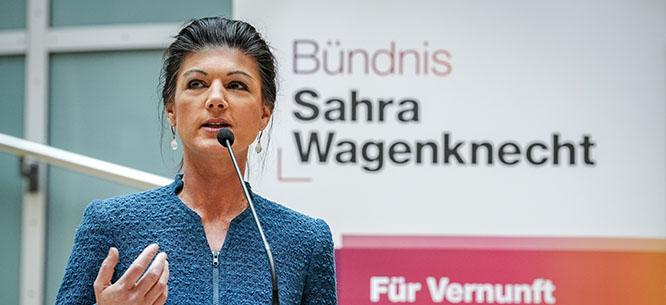Sahra Wagenknecht Divides the German Left
The former Die Linke politician’s new party embraces a model that has found purchase among sections of the left across the Global North: left-wing economics paired with a variety of political positions pulled from the right.

When the German MP Sahra Wagenknecht took the microphone at a press conference in October to explain why she was leaving Die Linke (the Left), she said she had to launch a new party because without dramatic change, “in ten years we will no longer recognize our country.” Her new party, the Sahra Wagenknecht Alliance—For Reason and Justice, aims to resolve Germany’s existential crisis.
In a country that designed its electoral system to disincentivize the politics of charisma, naming a party after yourself is a controversial move. Just as notable was Wagenknecht’s decision to forgo the label “left”—a term she claimed is now more associated with issues like pronouns and racism than a commitment to reducing social inequality, and therefore does more to alienate voters than to attract them. By taking nine other Die Linke MPs with her, Wagenknecht ensured that her former party would no longer be large enough to count as a full fraction in parliament, losing not just federal funding but also the right to give full-length speeches.
Wagenknecht had been part of Die Linke and its predecessor parties since 1989, and she was undoubtedly its most prominent politician. She is a regular guest on talk shows, a bestselling author, and a savvy user of social media, with over 650,000 subscribers to her YouTube channel. In more recent years, she has built her reputation on her dissent from what she sees as shibboleths of the German left on gender, race, climate, and more. She has burnished an image of herself as a champion of a German working class that has been abandoned by mainstream politicians. The Sahra Wagenknecht Alliance, which early opinion polls suggest could capture up to 20 percent of the vote in national elections, embraces a model that has found purchase among sections of the left across the Global North: left-wing economics paired with a variety of political positions pulled from the right.
Wagenknecht’s rise to political prominence follows the winding path of the German left since the end of the Cold War. She joined the governing Socialist Unity Party in East Germany at the age of nineteen. After the fall of that state, the Socialist Unity Party refashioned itself as the Party of Democratic Socialism (PDS). As a university student, Wagenknecht was elected to the PDS’s national committee and joined its Marxist-Leninist faction, the Communist Platform. Upon discovering that her communist commitments were now out of fashion in a university system that purged humanities faculty from the dissolved East, she made use of her new freedom of movement to enroll at the University of Groningen in the Netherlands, where she wrote a master’s thesis on Marx’s interpretation of Hegel.
At the same time, her…
Subscribe now to read the full article
Online OnlyFor just $19.95 a year, get access to new issues and decades’ worth of archives on our site.
|
Print + OnlineFor $35 a year, get new issues delivered to your door and access to our full online archives.
|
Already a subscriber? Log in:
Source: dissentmagazine.org


